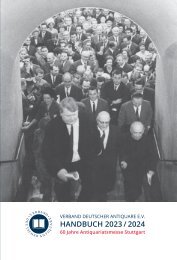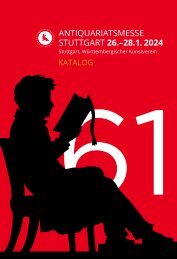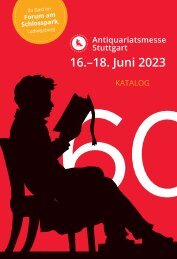Antiquariatsmesse Stuttgart 2022 - Katalog
Katalog zur Antiquariatsmesse Stuttgart 2022: Die diesjährige Antiquariatsmesse Stuttgart, Deutschlands bedeutendste Messe für schöne und seltene Bücher, Autographen, illustrierte Werke und Graphik findet, wie bereits im vergangenen Jahr pandemiebedingt nicht als klassische Messe, sondern in Form des gedruckten Kataloges und als digitale Messe auf bewährter Plattform (18. bis 22. Februar 2022) statt. 73 Antiquariate und Galerien aus Deutschland, Österreich und der Schweiz, den Niederlanden, Frankreich, England und den USA werden auch in diesem Jahr die gesamte Bandbreite des Antiquariatshandels präsentieren. Der gedruckte Katalog wird ab dem 31. Januar 2022 an interessierte Kunden verschickt, die virtuelle Messe öffnet ihre „digitalen Pforten“ am 18. Februar 2022 um 12.00 Uhr unter www.antiquariatsmesse-stuttgart.de
Katalog zur Antiquariatsmesse Stuttgart 2022: Die diesjährige Antiquariatsmesse Stuttgart, Deutschlands bedeutendste Messe für schöne und seltene Bücher, Autographen, illustrierte Werke und Graphik findet, wie bereits im vergangenen Jahr pandemiebedingt nicht als klassische Messe, sondern in Form des gedruckten Kataloges und als digitale Messe auf bewährter Plattform (18. bis 22. Februar 2022) statt.
73 Antiquariate und Galerien aus Deutschland, Österreich und der Schweiz, den Niederlanden, Frankreich, England und den USA werden auch in diesem Jahr die gesamte Bandbreite des Antiquariatshandels präsentieren.
Der gedruckte Katalog wird ab dem 31. Januar 2022 an interessierte Kunden verschickt, die virtuelle Messe öffnet ihre „digitalen Pforten“ am 18. Februar 2022 um 12.00 Uhr unter www.antiquariatsmesse-stuttgart.de
Erfolgreiche ePaper selbst erstellen
Machen Sie aus Ihren PDF Publikationen ein blätterbares Flipbook mit unserer einzigartigen Google optimierten e-Paper Software.
A fine copy of the first edition of this very rare botanical<br />
work describing one hundred woody plants, with fruit<br />
and flowers growing wild in Germany. The colouring<br />
of the plates is of an unusual high standard, and belongs<br />
to the very best produced in southern Germany at its<br />
summit of fine natural history production. The plates<br />
are engraved and drawn by G. F. Abel himself, a <strong>Stuttgart</strong><br />
artist and engraver. Apart from this and one other<br />
work, also by Reiter, he is otherwise unknown as a<br />
botanical artist. One technique employed, unusual in<br />
colour-plate botanical books, is the use of background<br />
shadows to give the illusion of the plants standing<br />
slightly above the surface of the page. Reiter was a<br />
botanist and forester; he was forestry commissioner<br />
at <strong>Stuttgart</strong> 1794–1801 and later in the Württemberger<br />
forestry department. The Burgsdorf work referred to<br />
in the title is his “Anleitung zur sichern Erziehung …”<br />
1787. The plates are in mint condition. – Nissen BBI,<br />
1617; Stafleu & Cowan 8971.<br />
Salm-Reifferscheid-Dyck, J. M. Fürst von. Monographia<br />
generum Aloes et Mesembryanthemi.<br />
Düsseldorf, Arnz; Bonn, Cohen, 1836–1863. 4to<br />
(315 × 245 mm). 7 parts bound in 3 volumes. With<br />
352 partly handcoloured lithographed plates and<br />
explanatory text. Contemporary half calf, spines in<br />
3 compartments with gilt lettering. € 18 000,–<br />
First and only edition. A foundation work on succulents,<br />
describing many South African species. Prince Joseph<br />
Maria von Salm-Reifferscheid-Dyck (1773–1861)<br />
was born at Castle Dyck near Düsseldorf. He was<br />
closely associated with the French botanists and botanical<br />
artists of the Napoleonic period. “His friendship<br />
for Redouté, the painter, who illustrated de Candolle’s<br />
‘Plantarum Succulentarum Historia’ led Salm-Dyck to<br />
devote himself thence-forward to the study of succulent<br />
plants. He took lessons in drawing and painting from<br />
his friend, and began to develop a living collection of<br />
succulents at Dyck …” (Curtis Botanical Magazine<br />
Dedications p. 67). Soon his collection of living succulent<br />
plants at Schloss Dyck became famous throughout<br />
Europe and was unrivalled at his time. “Das Buch blieb,<br />
wie gesagt, durch den Tod des Autors unvollständig,<br />
so dass der sicher beabsichtigte General-Index nicht<br />
erschienen ist … Die ‚Monographia‘’, seit langem vergriffen,<br />
ist, da die Nachfrage immer grösser wurde,<br />
rapide im Preis steigend, zumal vollständige Exemplare<br />
… geradezu verschwunden sind …” (Junk ‘Rara’ p.<br />
109). William T. Stearn published an annotated index<br />
to the work. The excellent plates are handcoloured<br />
lithographs of drawings by the author and are always<br />
partly coloured. Wilhelm Junk gives an exact collation<br />
of the work which agrees with the above offered copy.<br />
The work is a great rarity and we have only offered 2<br />
copies during the last decades. In our catalogue 276 we<br />
offered Prince Salm-Reifferscheid-Dyck’s own copy<br />
priced fl. 120.000 (about Euro 55 000). Due to the quality<br />
of the paper the book has some browning and foxing<br />
throughout. – Kerkham, Southern African Botanical<br />
Literature, no. 577; Junk Rara pp. 107–109; Nissen BBI,<br />
1720; Stafleu & Cowan TL2 10.129.<br />
Susemihl, J. C. Deutsche Ornithologie oder Naturgeschichte<br />
aller Vögel Deutschlands in naturgetreuen<br />
Abbildungen und Beschreibungen. Herausgegeben<br />
von Dr. Bekker, Lichthammer, C. W.<br />
Bekker und Lembcke. Neue Ausgabe. I.-XXII.<br />
Heft mit 132 Abbildungen. Darmstadt, im Verlage<br />
von Carl Wilhelm Leske, (1837–1841). Folio<br />
(510 × 340 mm). 22 parts bound in one. With 132<br />
colour-printed and handcoloured engraved plates.<br />
Contemporary half calf, richly gilt decorated spine<br />
with gilt lettering and yellow boards (rebacked preserving<br />
old spine). € 19 000,–<br />
A fine complete and uncut copy of the second edition.<br />
The first edition published from 1811–1817 is rarely<br />
found complete due to the interruption of publication<br />
by the Napoleonic wars. One of the most attractive<br />
German ornithological works. “… a work by which it<br />
was attempted to create a German parallel to the sumptuous<br />
ornithological works of other countries, notably<br />
of France, e. g. Levaillant’s works, to which it was compared<br />
at that time … and with which it is quite comparable<br />
on account of its beautiful plates. These were<br />
drawn, engraved, printed, and coloured, by Susemihl in<br />
co-operation with his brother, J. Th. Susemihl, and later<br />
on his son, Eduard Susemihl” (Anker 52). “Die von ihm<br />
gestochenen, gedruckten und illuminierten 132 Tafeln<br />
sind so vortrefflich gelungen, dass sie … Glanzstücke<br />
der Vogeldarstellungen wurden“ (Gebhardt p. 353).<br />
„Doch war Susemihl selbst ein eifriger Jäger, der seine<br />
Objekte nicht nur ausgestopft kannte. Davon legen<br />
die Tafeln, die im Stich wie Kolorit zu den Spitzenleistungen<br />
des späten Kupferstiches gehören, beredtes<br />
Zeugnis ab, ebenso wie die Vorlagen in Gouachemalerei,<br />
welche in der Darmstädter Galerie aufbewahrt<br />
werden“ (Nissen p. 53). The work is frequently listed<br />
under Borkhausen, who was one of the editors of the<br />
first edition. – Schlenker 55, 2; Nissen IVB, 907; Fine<br />
Bird Books 61. – Siehe Abbildung.<br />
97






